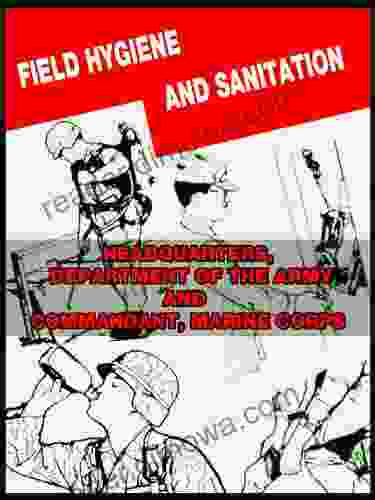Field Hygiene and Sanitation: Your Essential Guide to Staying Healthy in Challenging Conditions

Embark on a journey to master the art of field hygiene and sanitation, equipping yourself with the knowledge and skills to thrive in even the most demanding environments. This comprehensive guide will empower you to protect your health, prevent disease, and maintain well-being when access to modern conveniences is limited.
5 out of 5
| Language | : | English |
| File size | : | 5054 KB |
| Text-to-Speech | : | Enabled |
| Screen Reader | : | Supported |
| Enhanced typesetting | : | Enabled |
| Word Wise | : | Enabled |
| Print length | : | 128 pages |
Understanding the Importance of Field Hygiene
In the absence of proper hygiene practices, unsanitary conditions can rapidly deteriorate into breeding grounds for disease. Understanding the principles of field hygiene is crucial for safeguarding your health and the health of those around you. This includes:
- Personal hygiene: Maintaining cleanliness of your body, clothing, and belongings to prevent the spread of bacteria and infection.
- Water purification: Treating contaminated water sources to make them safe for drinking and cooking.
- Waste disposal: Properly disposing of human waste, garbage, and other refuse to minimize health risks and environmental pollution.
- Camp sanitation: Establishing and maintaining clean and sanitary living areas in field environments to prevent the spread of disease.
Field Hygiene Practices for Optimal Health
Implementing effective field hygiene practices is essential for preventing illness and ensuring a healthy and productive environment. Key practices include:
- Hand hygiene: Wash your hands frequently with soap and water, or use hand sanitizer when soap and water are not available. This is especially important after using the bathroom, handling food, or coming into contact with potentially contaminated materials.
- Body hygiene: Take regular baths or showers using soap and water. Keep your clothes clean and dry to prevent skin irritation and infection.
- Dental hygiene: Brush and floss your teeth regularly to prevent tooth decay and gum disease.
- Toilet hygiene: Use clean latrines or dig a latrine pit when necessary. Dispose of human waste properly to prevent contamination of water sources and the spread of disease.
- Food hygiene: Cook food thoroughly to kill harmful bacteria. Avoid eating raw or undercooked meat, fish, or eggs. Store food properly to prevent spoilage.
Water Purification Techniques for Safe Drinking Water
Access to clean drinking water is essential for survival in field conditions. This can be achieved through various water purification techniques, including:
- Boiling: Boiling water for at least one minute kills most bacteria and viruses.
- Chemical disinfection: Using water purification tablets or chlorine drops to kill pathogens.
- Filtration: Passing water through a filter to remove particles and microorganisms.
- Solar disinfection: Exposing water to direct sunlight for several hours can kill pathogens.
Waste Disposal Practices for Environmental Protection
Proper waste disposal is essential for preventing environmental pollution and protecting human health. Key practices include:
- Human waste disposal: Use designated latrines or dig latrine pits. Bury human waste at least 6 inches deep to prevent contamination of water sources.
- Garbage disposal: Collect and store garbage in designated containers. Burn or bury garbage when possible, or pack it out for proper disposal at a designated waste site.
- Hazardous waste disposal: Handle and dispose of hazardous materials, such as batteries and fuels, with utmost care. Follow specific guidelines for the disposal of these materials.
Camp Sanitation for a Healthy Environment
Maintaining a clean and sanitary camp environment is essential for preventing the spread of disease and promoting well-being. Key practices include:
- Campsite selection: Choose a campsite with good drainage, away from water sources and potential sources of contamination.
- Waste management: Establish designated areas for waste disposal and ensure proper handling and disposal of human waste, garbage, and hazardous materials.
- Water management: Ensure access to clean water for drinking, cooking, and sanitation. Protect water sources from contamination.
- Pest control: Implement measures to prevent pests, such as rodents and insects, from entering the camp.
Field Hygiene and Sanitation in Special Situations
In certain situations, additional field hygiene and sanitation considerations may be required:
- Military hygiene: Soldiers face unique challenges in maintaining hygiene and sanitation in combat zones. This requires specialized knowledge and equipment.
- Disaster relief: Natural disasters can disrupt infrastructure and access to essential services, making field hygiene and sanitation a critical priority.
- Travel hygiene: When traveling to underdeveloped regions, it is essential to take precautions to prevent exposure to diseases. This includes practicing good personal hygiene, drinking only safe water, and avoiding contaminated food.
Mastering the art of field hygiene and sanitation is an indispensable skill for anyone venturing into challenging environments. By understanding the principles and implementing effective practices, you can safeguard your health, prevent disease, and maintain well-being in even the most adverse conditions. Embrace the knowledge and empower yourself to thrive in any situation.
Free Download your copy of Field Hygiene and Sanitation today and embark on a journey to become an expert in protecting your health and well-being in any environment.
5 out of 5
| Language | : | English |
| File size | : | 5054 KB |
| Text-to-Speech | : | Enabled |
| Screen Reader | : | Supported |
| Enhanced typesetting | : | Enabled |
| Word Wise | : | Enabled |
| Print length | : | 128 pages |
Do you want to contribute by writing guest posts on this blog?
Please contact us and send us a resume of previous articles that you have written.
 Book
Book Novel
Novel Page
Page Chapter
Chapter Text
Text Story
Story Genre
Genre Reader
Reader Library
Library Paperback
Paperback E-book
E-book Magazine
Magazine Newspaper
Newspaper Paragraph
Paragraph Sentence
Sentence Bookmark
Bookmark Shelf
Shelf Glossary
Glossary Bibliography
Bibliography Foreword
Foreword Preface
Preface Synopsis
Synopsis Annotation
Annotation Footnote
Footnote Manuscript
Manuscript Scroll
Scroll Codex
Codex Tome
Tome Bestseller
Bestseller Classics
Classics Library card
Library card Narrative
Narrative Biography
Biography Autobiography
Autobiography Memoir
Memoir Reference
Reference Encyclopedia
Encyclopedia Phd Johanna Blomqvist
Phd Johanna Blomqvist Vivien Gorham
Vivien Gorham Michael Leventhal
Michael Leventhal Niloufar Shafiei
Niloufar Shafiei Louise Gluck
Louise Gluck Pranav Zope
Pranav Zope Trista Mateer
Trista Mateer Lisa Moser
Lisa Moser Robert Vaughan
Robert Vaughan Shawn Middleton
Shawn Middleton Marcus Chen
Marcus Chen Zarqnon The Embarrassed
Zarqnon The Embarrassed Nora Wall
Nora Wall Paul Belasik
Paul Belasik Susan Fletcher
Susan Fletcher Seth Earley
Seth Earley Lila Segal
Lila Segal Matt Mcafee
Matt Mcafee Tom O Connell
Tom O Connell M V Echa
M V Echa
Light bulbAdvertise smarter! Our strategic ad space ensures maximum exposure. Reserve your spot today!
 Roger TurnerFollow ·9.4k
Roger TurnerFollow ·9.4k Edward BellFollow ·16.6k
Edward BellFollow ·16.6k Eric NelsonFollow ·11.8k
Eric NelsonFollow ·11.8k Miguel de CervantesFollow ·3k
Miguel de CervantesFollow ·3k Jerome PowellFollow ·8.7k
Jerome PowellFollow ·8.7k Jorge Luis BorgesFollow ·16.1k
Jorge Luis BorgesFollow ·16.1k Albert ReedFollow ·13.3k
Albert ReedFollow ·13.3k Yukio MishimaFollow ·17.4k
Yukio MishimaFollow ·17.4k

 Justin Bell
Justin BellBedtime Story in English and American Sign Language: A...
Embark on a...

 Eli Blair
Eli BlairUnlock Your Compensation Plan Potential: An In-Depth...
In the realm of sales and network...

 Asher Bell
Asher BellAn Adventurous Tale Filled With Architectural Cultural...
Prepare yourself for an enthralling...

 Jeremy Mitchell
Jeremy MitchellStories from My Life and Blue Jays Baseball
By Paul Beeston In...

 Tim Reed
Tim ReedDiscover the Hidden Culinary Gems of New York City with...
Embark on a Culinary Adventure through the...

 Natsume Sōseki
Natsume SōsekiFootball Physics: Unlocking the Secrets of the Beautiful...
Football is a game...
5 out of 5
| Language | : | English |
| File size | : | 5054 KB |
| Text-to-Speech | : | Enabled |
| Screen Reader | : | Supported |
| Enhanced typesetting | : | Enabled |
| Word Wise | : | Enabled |
| Print length | : | 128 pages |












